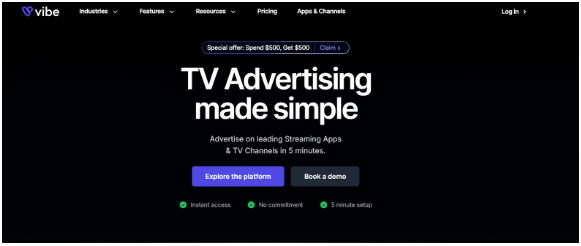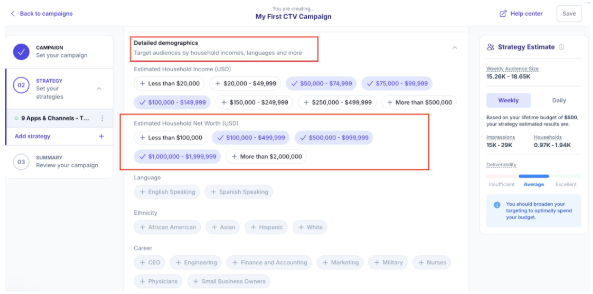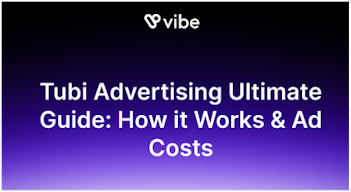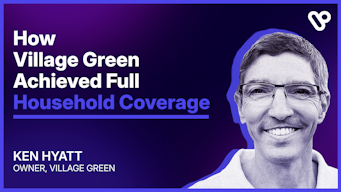Broadcast TV Advertising: 5 Advantages and Disadvantages
Are you thinking about using broadcast TV advertising to promote your brand but unsure if it’s the right move?
If you’ve been wondering whether this traditional advertising method is still effective, you’re not alone.
Broadcast TV has been a cornerstone of mass marketing for decades, but with so many options available today, it’s important to understand both the benefits and the challenges it brings.
In this blog, I’ll cover:
- What broadcast TV advertising is and how it works.
- 5 key advantages of using broadcast TV to reach your audience.
- 5 major disadvantages that could impact your ROI.
- Why many brands are turning to streaming TV advertising as an alternative?
- How tools like Vibe.co help businesses embrace modern advertising strategies.
By the end, you’ll have a clear understanding of whether broadcast TV is the right choice for your next campaign and how it compares to the streaming alternatives.
So, let’s begin!
What Is Broadcast TV Advertising?
Broadcast TV advertising is when businesses promote their products or services through commercials aired on traditional television networks like ABC, CBS, or NBC.
These ads appear during scheduled programs and are designed to reach large audiences watching TV at the same time.
How Does Broadcast TV Advertising Work?
- Creating the Ad: You start by producing a short video advertisement, usually between 15 to 60 seconds, to communicate your message.
For instance, a car brand might create an ad showing the vehicle in action, highlighting its features.
- Buying Airtime: Once your ad is ready, you buy a "time slot" from a TV network.
These time slots vary in cost based on:
- When the ad will air: Prime-time hours, when most people are watching, are more expensive.
- What program it airs with: Ads during popular shows or events, like the Super Bowl, cost more because of the larger audience.
- Who you want to reach: You can target local viewers (a specific city or region) or a national audience.
- Broadcasting the Ad: Your ad is aired during the selected time slot, reaching everyone watching that channel at the time. For example, an ad aired during a live football game might reach millions of viewers simultaneously.
Types of Broadcast TV Advertising
There are several ways businesses can advertise on broadcast TV, depending on their goals and budget.
- Traditional Commercials (TV Spots): These are the standard ads you see during commercial breaks. They usually last 15, 30, or 60 seconds and promote a product, service, or brand.
- Live Event Sponsorships: Instead of just airing a commercial, brands can sponsor an event like a sports game or award show. Their name and logo appear throughout the broadcast.
- Infomercials: These are longer TV ads, usually between 5 to 30 minutes, designed to explain and demonstrate a product in detail. For example, a kitchen appliance brand running a 15-minute infomercial showing recipes and special offers.
- Product Placement: Instead of running an ad, brands pay to have their products featured within a TV show or movie.
- Political Ads: These ads are used by candidates and political groups to promote campaigns and policies, especially during elections.
Each type of ad serves a different purpose, whether it’s raising awareness, driving sales, or building credibility. But how do businesses actually use them?
Examples of Broadcast TV Advertising
Many brands have successfully used broadcast TV ads to make a lasting impact. Here are a few well-known examples:
- Apple’s "1984" Super Bowl Ad – This iconic commercial introduced the Macintosh computer with a bold, cinematic approach.
- Budweiser’s "Whassup?" Campaign – A fun, memorable ad that became a cultural catchphrase.
- Old Spice’s "The Man Your Man Could Smell Like" – A creative and humorous campaign that helped redefine the brand’s image.
- Local Business Ads – Many small businesses, like law firms, car dealerships, and restaurants, run TV ads during regional news programs to reach local customers.
In the next section, we’ll explore the pros and cons of broadcast TV advertising to help you decide if they’re still worth it today.
5 Advantages of Broadcast TV Advertising
Broadcast TV advertising remains a trusted medium for businesses aiming to reach wide audiences effectively.
Here are the five advantages of broadcast TV advertising approach:
- Massive Audience Reach
These networks are accessible to anyone with an antenna or basic cable, ensuring a broad viewer base.
This makes broadcast TV ideal for campaigns focused on national or regional brand awareness.
- Engaging Visual and Audio Content
Broadcast TV combines sight, sound, and motion to create engaging advertisements.
This multi-sensory approach ensures that messages are not only seen but also heard, making them more memorable.
Compared to other mediums like print or radio, broadcast TV ads are better at capturing attention and delivering impactful storytelling.
- Building Brand Credibility
Broadcast TV networks are trusted sources of news and entertainment.
Advertising on these channels enhances a brand’s credibility by associating it with well-regarded programs.
- Options for Local or National Targeting
Broadcast TV provides flexibility in audience targeting.
Businesses can choose local TV affiliates to focus on specific regions or advertise on national networks to reach a broader audience.
This versatility makes it suitable for small businesses looking to attract local customers or large brands running nationwide campaigns.
- Captive Audiences During Live Events
Live events like sports games or award shows are key strengths of broadcast TV.

Viewers are less likely to skip ads during live programming, which makes these time slots highly effective for engaging audiences.
However, while broadcast TV advertising offers significant benefits, it’s equally important to consider its drawbacks.
5 Disadvantages of Broadcast TV Advertising
Broadcast TV advertising remains a widely used marketing channel, but it comes with notable drawbacks.
Here are the five common disadvantages of broadcast tv advertising:
- High Costs
Broadcast TV advertising requires significant financial investment.
- Airtime on major networks during prime-time shows or live events can be expensive.
- Production costs for creating high-quality commercials add to the overall expense.
- Limited Targeting Precision
Broadcast TV delivers ads to broad audiences but lacks the ability to target specific demographics precisely.
- Your ad may reach viewers who are unlikely to be interested in your product or service.
- For example, an ad for a niche product may be wasted on a general audience watching a popular news program.
- Declining Viewership
The rise of streaming platforms and on-demand content has led to a decline in live TV audiences.
- Younger viewers are increasingly shifting to platforms like Netflix and YouTube, where traditional ads may not reach them.
- This shrinking audience reduces the potential impact of broadcast TV advertising.
- Ad-Skipping and Channel Surfing
Broadcast TV audiences have more control over how they watch content, often skipping ads entirely.
- Technologies like DVRs allow viewers to fast-forward through commercials.
- During ad breaks, many viewers switch channels or divert their attention to other activities.
These behaviors decrease the likelihood that your ad will be seen. - Difficult to Measure ROI
Unlike digital advertising, broadcast TV lacks detailed tracking and analytics.
- It’s challenging to determine how many viewers watched your ad or took action afterward.
- Without precise data, it’s harder to calculate the return on investment and optimize future campaigns.
Broadcast TV advertising has its limitations, but understanding these challenges can help you decide if it’s the right fit for your marketing strategy.
Why Streaming TV Is a Better Option for Modern Advertisers
Streaming TV advertising has quickly become a preferred choice for modern advertisers, offering features that address many of the limitations of broadcast TV advertising.
Below is a clear comparison to highlight why streaming TV is a better option:
Broadcast TV vs. Streaming TV Advertising
| Feature | Broadcast TV Advertising | Column B |
|---|---|---|
| Audience Reach | Declining due to the shift to digital and streaming platforms. | Growing rapidly, especially among younger, tech-savvy viewers. |
| Targeting Precision | Broad targeting with limited audience segmentation. | Granular targeting is based on demographics, interests, location, and behavior. |
| Cost | High upfront costs for production and airtime. | Flexible pricing allows businesses to scale campaigns based on budget. |
| Engagement | Ads are often skipped or ignored during commercial breaks. | Ads appear during on-demand viewing, ensuring active engagement. |
| Analytics and ROI | Limited metrics; difficult to measure direct impact. | Real-time data for impressions, engagement, and ROI optimization. |
| Scalability | Better suited for large companies with significant budgets. | Accessible for businesses of all sizes, from local startups to global brands. |
Streaming TV advertising outperforms broadcast TV in several key areas, including audience targeting, cost efficiency, and real-time analytics.
Now, let’s explore how tools and platforms can simplify the shift from traditional to streaming TV advertising, ensuring your campaigns are efficient and impactful.
How Vibe.co Simplifies Streaming TV Advertising

If you’ve been considering streaming TV advertising but aren’t sure where to start, Vibe.co might be just what you need.
Shifting from traditional TV to streaming can feel like a big change, but Vibe.co makes the process easy and approachable.
Here’s how Vibe.co transforms streaming TV advertising into a simple and effective process:
1. Quick and Easy Campaign Setup
In less than five minutes, you can create and launch a campaign without being tied to long-term commitments.
This makes it a great option if you want to experiment with streaming ads or adjust your strategy as you go.
2. Targeting the Right Audience
One of the biggest advantages of Vibe.co is how precisely you can target your audience.

Instead of showing your ad to just anyone, you can reach:
- Specific Locations: Target viewers in specific cities or even zip codes.
- Demographics: Focus on groups based on age, gender, or income level.
- Interests and Behaviors: Reach people whose viewing habits match your audience, like fitness enthusiasts or avid gamers.
This level of targeting ensures your ads are seen by the people most likely to care about your product or service.
3. Real-Time Performance Tracking
Unlike traditional TV ads, where results can feel vague, Vibe.co gives you real-time insights into how your ads are performing.
You can track:
- How many people have seen your ad?
- What each view is costing you.
- How well your campaign is meeting your goals.
This data helps you make informed decisions and adjust your ads while they’re still running.
4. Affordable and Flexible Advertising

You can start with a budget as low as $50 per day, and some campaigns cost as little as $0.02 per view.
This flexibility allows you to scale your efforts as you see results, making it a great fit for both small businesses and larger brands.
5. Works Seamlessly with Your Marketing Strategy
Vibe.co allows you to integrate your ads with broader marketing efforts, like social media campaigns or digital ads, so your messaging stays consistent across platforms.
Conclusion
Broadcast TV had its time, but people are watching streaming platforms now.
If your ads aren’t there, you’re missing out.
Here’s why you should give vibe.co a try:
- You can set up your ad in just a few clicks.
- Your ads reach the right people, not just anyone.
- You can start with as little as $50.
- Real-time data shows you how your ads are doing.
Still thinking about sticking to broadcast TV advertising?
Think again.
Streaming is where your audience is now, and Vibe.co makes sure you don’t get left behind.
With Vibe.co, you can place your ads on premium streaming content—TV shows, movies, and live sports—so your brand is seen by viewers who are actually paying attention.
Try Vibe.co today and see how easy streaming TV advertising can be.
Frequently Asked Questions
1. What is broadcast TV advertising?
Broadcast TV advertising involves airing commercials on television networks during scheduled programming to reach a broad and diverse audience.
2. How effective is broadcast TV advertising?
Despite the rise of digital media, broadcast TV advertising remains effective for building brand awareness and reaching large audiences. It allows advertisers to deliver engaging audio-visual messages that can influence consumer purchasing decisions.
3. What are the costs associated with broadcast TV advertising?
The cost of broadcast TV advertising varies based on factors like the time slot, program popularity, and geographic location. Prime-time slots or major events like the Super Bowl can be significantly more expensive due to higher viewership.
4. How can I measure the success of my TV advertising campaign?
Success can be measured using metrics such as reach, frequency, impressions, brand awareness, message recall, and purchase intent. Analyzing these metrics helps determine the campaign's effectiveness and return on investment.
5. Is TV advertising still relevant in the age of digital media?
Yes, TV advertising continues to be relevant. It offers unique advantages like extensive reach, credibility, and the ability to deliver impactful visual and auditory messages that resonate with viewers.



